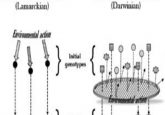The burden of being brainy

There’s a reason why not all species can do calculus. A new model species offers insight into why.

It’s not easy being smart. Oscar Wilde once lamented: “I am so clever that sometimes I don’t understand a single word of what I am saying.”
Braininess is also expensive—energetically, that is—as increased grey and white matter creates a greater metabolic demand. While a larger brain conveys greater cognitive power that can make survival easier, extreme encephalization (the evolution of a large brain to body mass ratio) comes at a cost to fitness.
A few species, such as ourselves, have circumnavigated this cost to evolve large brains relative to our body mass. But how have we gotten around this evolutionary obstacle? A new study published in PLoS Biology characterized large brains in a model fish species and demonstrated an evolutionary mechanism that facilitates extreme encephalization.
“So much of our thinking about evolution is focused on the benefits of evolving a really big brain,” said corresponding author Bruce Carlson. “But a lot of it neglects the costs, and that is something you have to consider in any evolutionary study as a driving force of natural selection.”
There are two prominent ideas explaining how species may have side-stepped the costs of extreme encephalization. The Direct Metabolic Constraint Hypothesis predicts that increases in the energy consumed pay for the higher energy demands caused by a bigger brain, whereas the Energetic Trade-off Hypothesis states that reducing energy required in other organs allows bigger brains to evolve. Studies have supported both of these ideas, although few have focused on species with extreme encephalization.
While not world-renowned for their intelligence, fish helped tackle this debate. African mormyrid electric fishes are commonly known as elephant fish due to their long mouth extensions that resemble a large trunk. “They were an obvious choice as they have a surprisingly large brain relative to their body size, which in some species is equivalent to humans,” said lead author Kimberly Sukhum. “They are also incredibly diverse, with over 200 species, allowing the use of comparative studies to look for correlations between different traits.”
The researchers used phylogenetic mapping to compare brain and body size in 30 mormyrid species. Extreme encephalization varied between species, with brain size showing no strong linear correlation with the size of the other organs. This suggested that the Energetic Trade-off Hypothesis was not valid for understanding why elephant fish had such big brains.
To see whether the Direct Metabolic Constraint Hypothesis applied, the team measured energy use by determining the rate of oxygen consumption. They also measured the ability of each species to survive in low oxygen concentrations. The bigger-brained species showed a strong correlation with increased energy consumption and a lower tolerance of hypoxia, supporting this hypothesis.
“There is clearly good evidence in favor of both hypotheses. And depending on which critters you’re looking at, I think in some sense they’re both correct, with the two reconciled into a bigger framework,” said Carlson. “If your brain gets a little larger, you might be able to achieve that by skimping and using energetic costs elsewhere. If you want to evolve a really large brain with a quantum leap in size, then it may be that there’s not enough to do that and you can only reduce expenses. It may be that in that situation you have to have an increase in the budget.”
According to Carlson, these details pave the way to understanding extreme encephalization in humans. Researchers can search for candidate the genes involved in driving changes in brain size using comparative genomics and transcriptomics approaches and then study those candidate genes in primates.
This is indeed one of the team’s long-term goals, although they will first look at more specific areas of the elephant fish’s brain to further unlock the secrets of extreme encephalization. “It’s particularly the cerebellum that appears to be increasing, so we plan to use micro CT scans to look at these regions and see how they are relative to overall brain size,” stated Sukhal.





